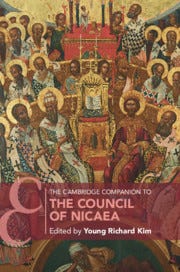Young Richard Kim (ed).
The Cambridge Companion to the Council of Nicaea
New York: Cambridge University Press, 2021.
Cambridge University Press is producing a string of biblical and patristic “companions” including the New Testament, apostle Pal (2nd edition), Gospels (2nd edition), Apostolic Fathers, and now the Council of Nicaea.
For those who don’t know, the Council of Nicaea took place in 325 AD at the behest of the emperor Constantine - recently made unrivalled emperor of west and east - to deal with a schism in the church caused by a Libyan presbyter named Arius and bishop Alexander of Alexandria. The issue was in what sense was Jesus divine? Was he divine like an archangel or divine in the same way as God the Father. Plus a few other things to be sorted out, like the date of Easter.
Anyways, this book deals with the lead, conduct, and aftermath of the Council of Nicaea.
The book is divided into five sections:
Contexts
The Council
Outcomes
The Aftermath
The Long Reception
To give some highlights, Raymond Van Dam thinks that there was political and propaganda motivations at Nicaea as “The emperor and Jesus each seemed to be an analogue of each other” (39). Eusebius of Caesarea certainly thought so, but his sycophantic panegyric to Constantine should not be confused with the origins, purpose, meaning, and reception of Nicaea.
Rebecca Lyman has a great chapter on Arius and Arianism and gives a sympathetic treatment of Arius.
H. A. Drake has a chapter on “The Elephant in the Room” about the influence of Constantine in the council. He concludes: “Whereas Constantine’s right to participate at Nicaea may be taken for granted, the impact of that participation is harder to evaluate” (131).
One highlight of the volume is Mark Edward’s chapter on the creed of Nicaea itself, including its antecedents, wording, and accompanying anathemas.
David Gwynn points out why the language of homoousios (same substance) had to be used! “The assembled bishops sought to express the orthodox faith in scriptural terms, but under cross-examination the [pro-Arian] ‘Eusebians’ were constantly able to interpret those terms along ‘Arian’ lines. The bishops were thus forced to invoke langauge from outside the scriptures, and so affirmed the Son as ‘from the ousia [being/substance] of God’ and homoousios with the Father” (100).
The chapters by Sara Parvis and Mark Delcogliano map the controversies and debates that followed about the fitness of the language of homoousios and ousia in the coming decades. Over the next 50 years, the language of homoousios would even be banned and declared heretical by councils under imperial pressure. The church would be divided into pro-Nicenes, Homoians, Homoiousians, and Heteroousians! Parvis has a great conclusion, “The Council of Constantinople of 381 decided that there was only one thing worse than affirming that the Son was homoousios with the Father, and that was not affirming it” (253). She say about Athanasius and his dogged defense of homoousios: “In almost every year from 328- 373 … the odds were against the survival of the term homoousios. Its theological and political endurance depended above all on a man, who was simultaneously a brilliant theologian, consummate politician, and storyteller extraordinaire” (254).
Seriously, the chapters by Parvis and Delcogliano are worth the price of the book!
This is a great book for church history buffs, for courses on historical theology, and the patristic period. It is probably too technical for the average layperson out there. However, any serious student of church history should not be without it!
A few other interesting things related to Nicaea:
Check out my Council of Nicaea rap battle.
There is a Council of Nicaea role-playing game.
There is a Dr. Who audio episode about the Council of Nicaea where Athanasius is the bad guy!




